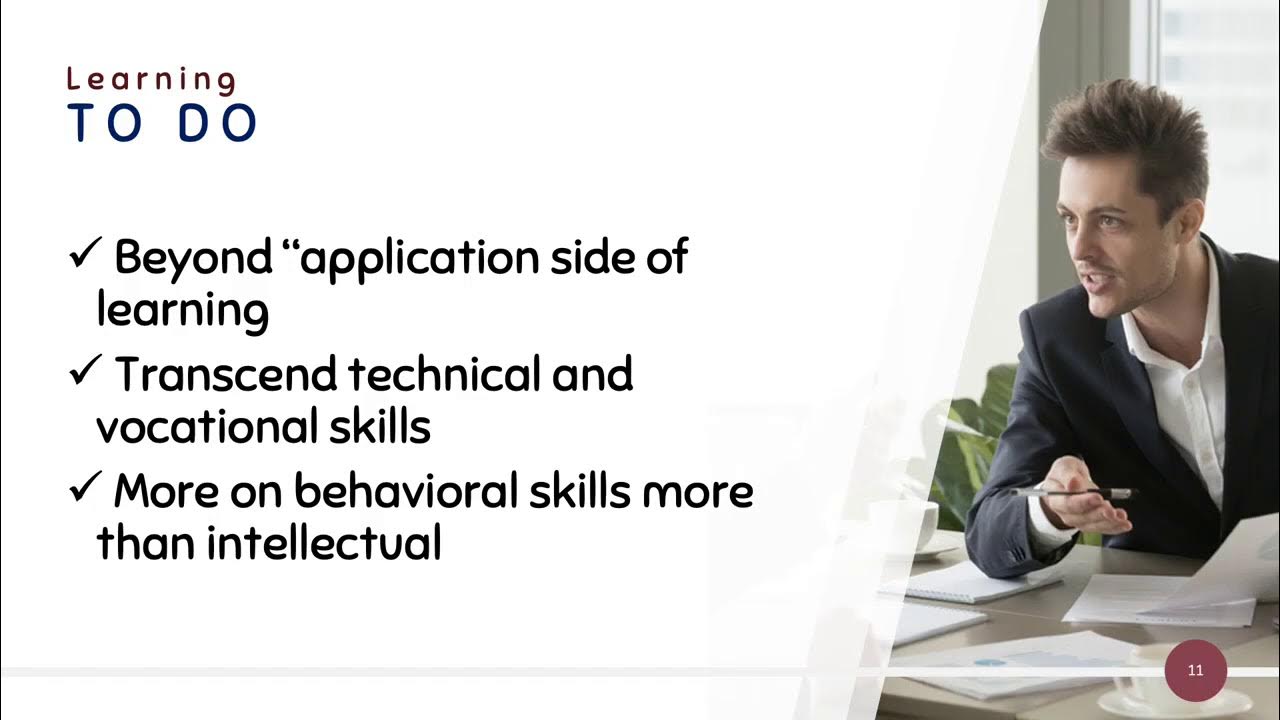DDIP | Pilar-pilar Pendidikan
Summary
TLDRThe video discusses the five pillars of education, starting with UNESCO’s four key pillars: learning to know, learning to do, learning to be, and learning to live together. These pillars represent essential elements for a balanced educational foundation, emphasizing knowledge, action, personal development, and community living. Additionally, the video highlights a fifth pillar unique to Indonesia, 'learning to be live in God,' reflecting the country's religious principles as the core foundation of its education system. The discussion emphasizes the importance of these pillars working together to create a well-rounded educational experience.
Takeaways
- 😀 The concept of education pillars is based on the idea of 'pillars' or support beams, which must stand equally for effective education.
- 😀 UNESCO's framework for education includes four main pillars: 'Learning to Know,' 'Learning to Do,' 'Learning to Be,' and 'Learning to Live Together.'
- 😀 'Learning to Know' emphasizes the importance of acquiring knowledge and understanding key information or phenomena.
- 😀 'Learning to Do' refers to the application of knowledge and skills to real-life situations, focusing on practical action.
- 😀 'Learning to Be' involves personal growth and developing the qualities of the individual one aims to become.
- 😀 'Learning to Live Together' aims to equip individuals with the ability to live harmoniously in a social community.
- 😀 These four pillars should be balanced and work together to create a solid foundation for education.
- 😀 In addition to UNESCO's four pillars, Indonesia includes a fifth pillar: 'Learning to Be Live in God,' rooted in the country's foundation of spirituality.
- 😀 The fifth pillar in Indonesia reflects the nation's commitment to integrating spirituality and religion into its educational practices.
- 😀 The five pillars together form a comprehensive framework for education that balances intellectual, personal, social, and spiritual development.
- 😀 The script encourages the integration of these pillars to ensure that education serves both individual and societal needs effectively.
Q & A
What are the four UNESCO pillars of education?
-The four UNESCO pillars of education are: Learning to Know (acquiring knowledge), Learning to Do (applying knowledge), Learning to Be (personal development), and Learning to Live Together (social integration and cooperation).
What is the purpose of the pillar 'Learning to Know'?
-The purpose of the 'Learning to Know' pillar is to focus on the acquisition of knowledge, allowing students to understand various concepts, facts, and phenomena in the world.
How does the pillar 'Learning to Do' complement 'Learning to Know'?
-'Learning to Do' builds upon 'Learning to Know' by emphasizing the application of the knowledge acquired. It focuses on how students can use their knowledge in real-world situations.
What does the pillar 'Learning to Be' aim to achieve in education?
-'Learning to Be' aims at personal development, guiding students to become the kind of individuals they aspire to be and contributing positively to society.
What is the significance of the pillar 'Learning to Live Together'?
-'Learning to Live Together' focuses on preparing individuals to live in harmony with others in society, promoting social understanding, empathy, and cooperation.
What is the fifth pillar of education specific to Indonesia?
-The fifth pillar specific to Indonesia is 'Learning to Be Live in God,' which emphasizes the integration of spirituality and religious values into the educational framework.
Why is the pillar 'Learning to Be Live in God' important in Indonesia?
-The pillar 'Learning to Be Live in God' is important in Indonesia because the nation’s foundation is based on the belief in God, and education needs to reflect and honor these spiritual values.
How do the five pillars of education work together in Indonesia’s educational system?
-In Indonesia, the five pillars work together to ensure a balanced education that fosters knowledge acquisition, personal growth, social harmony, and spiritual development, all in alignment with the nation’s values.
What role does the concept of 'learning' play in the four UNESCO pillars?
-In the UNESCO pillars, 'learning' is central as it guides individuals through different stages: acquiring knowledge (Learning to Know), applying knowledge (Learning to Do), developing personal character (Learning to Be), and fostering social harmony (Learning to Live Together).
What are the practical implications of the 'Learning to Do' pillar?
-'Learning to Do' has practical implications in that it encourages students to apply the knowledge they have gained in real-life situations, helping them to solve problems and take action based on their understanding.
Outlines

This section is available to paid users only. Please upgrade to access this part.
Upgrade NowMindmap

This section is available to paid users only. Please upgrade to access this part.
Upgrade NowKeywords

This section is available to paid users only. Please upgrade to access this part.
Upgrade NowHighlights

This section is available to paid users only. Please upgrade to access this part.
Upgrade NowTranscripts

This section is available to paid users only. Please upgrade to access this part.
Upgrade NowBrowse More Related Video

4 Pillars of Education

Paradigma Baru Pembelajaran PKN (Pendidikan Pancasila) di Kurikulum Merdeka

UDL 3 Pillars

KEYS to Great Teaching - Gradual Release of Responsibility

How to study with Video Resources | @PrepLaddermedpg , @marrowmed , @BoardsandBeyond , @kaplanmedical

MERAIH HARAPAN BERSAMA SEKOLAH ALAM
5.0 / 5 (0 votes)